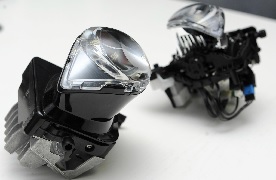Learn how to create an ergonomic and efficient workplace

 Automotive Lighting, owned by Magneti Marelli – part of Fiat Chrysler, is a leading provider of lights for the car industry. The development center in Jihlava is the second largest Automotive Lighting center in the Czech Republic. Lights developed in Jihlava can be found in cars from Porsche, BMW, Daimler, Skoda, Volkswagen, Renault, Honda and Peugeot.
Automotive Lighting, owned by Magneti Marelli – part of Fiat Chrysler, is a leading provider of lights for the car industry. The development center in Jihlava is the second largest Automotive Lighting center in the Czech Republic. Lights developed in Jihlava can be found in cars from Porsche, BMW, Daimler, Skoda, Volkswagen, Renault, Honda and Peugeot.
Siemens PLM Software solutions – from the Tecnomatix portfolio – are used not only to design products, but also to optimize working conditions in manufacturing. The manufacturing solutions are well-known to Automotive Lighting, where the Jack software was used to design a standardized ergonomic workplace that makes it possible to achieve higher levels of productivity and work efficiency.
Improving workplace ergonomics
Automotive Lighting operates two plants in the Czech Republic, in Pávov and Střítež. The Pávov plant deployed the Plant Simulation solution along with Jack human modeling and simulation software in 2010; the Střítež plant recently used Jack to realize significant benefits. Associates at the Střítež plant approached their management to adapt the manual assembly workplace, and the management team opted for a radical solution: to develop a new workplace with the use of leading-edge simulation technology, improving ergonomics to make more efficient work possible.
“It all began with the request to standardize the height of trolley paths in racks for the material, and to simplify the use of assembly lines,” says designer Lukáš Bratránek, adding that initially the request came from the logistics department. When fulfilling this request, Automotive Lighting analyzed the workplace in accordance with the Czech Republic’s government regulation Nařízení Vlády (NV) 361 occupational safety and health standard and determined that the assembly workplace, which was based on the headlight assembly workplace at the plant Pávov, was not suitable for the assembly of light-emitting diode (LED) modules, because they are much smaller than conventional headlights.
On the basis of these requirements, Automotive Lighting decided to develop a new design for the workplace. “We spoke to our colleagues, made statistical analyses and used the information to set up the optimum height of the assembly workplace and the height of the material trolley paths behind the workplace,” says Bratránek. The digital human figures of the Jack software helped to validate the workplace design for multiple human factors such as user comfort, reachability, line of sight, energy expenditure and injury risk.
In the prior design, most of the material was stored behind the workplace, which introduced problems due to the increasing complexity of the products. “The new assembly workplace solves these problems by placing some of the materials behind the assembly parts, and some under the adjustable-level portal in small boxes,” says Bratránek, explaining that in the original setup it was not possible to place the material under the working desk, and the company had to use side racks that are not ergonomically suitable.
Enhanced comfort for employees
The main benefits of the new workplace are quite clear. Because the workplace is standardized and tables and trolley paths are adjustable, assembly workers have greater comfort and can complete tasks more efficiently. The benefits are not limited to the comfort and efficiency of employees, but also include economic benefits, as Bratránek confirms: “These standards help maintain our competitiveness when calculating the costs of new projects. We can integrate the new product into the running line, and re-use the workplace and racks once the manufacturing is finished. We calculate only assembly parts, not the whole workplace and the rack system as we did in the past.”
Bratránek highly appreciates both the functionality and user-friendliness of the Siemens solutions. “I got to know the software really quickly,” he says. “About two and a half years ago I was transferred, because of capacity reasons, from Pávov to Střítež. A colleague who used Jack trained me within just four days, and I could begin working. I started with simple moving of computer-aided design objects. As far as functionality is concerned, I believe the digital human models of the software − Jack and Jill – are more capable than those of competitors.”
You can read the rest of the Automotive Lighting success story here.


